November 11, 2011
Dear friends and family,
Here are some photos of the planting, the celebration and the Egg ceremony. […] Thank you all for coming, for helping with the planting and the cooking, and for celebrating with us! And to those of you who would have liked to come but couldn’t: let’s celebrate Easter together, when everything is starting to bloom and we can hide a lot of eggs in the garden! I would also like to thank Paweł Freisler again for giving me permission to make a copy of his “Egg,” which I was allowed to carry around with me during the show.[1]
Much love to all of you,
Antje

Antje Majewski, Planting ceremony in Himmelpfort
January 3, 2012
Dear Antje!
First of all … my calendar, as you probably already noticed, is a bit different from the official one. (Which one?) Anyway … officially we already have 2012, which means that I am about 3 months behind in my time count (maybe more, but no more than 3 years).
I wish you the best for all occasions.
Apropos: Your show in Graz had a beginning but I cannot see the end. (Of course I received the catalogue, which means that I have crossed one of the deadlines for this show). I know that the show will be taken down to make room for something else and will become “history.” I have to tell you that the time after the show is still interesting for me. Thank you very much for sending me the photos. Some of them will have an important place in my collection. Waiting for more. One rule: Do not depend on whether you hear from me or not.
I wish you luck and hope that all the planted trees will bloom!
Please give my greetings to all your family and friends involved,
Paweł
January 7, 2012
Dear Paweł,
I also wish you all the best for all occasions, all years, and all minutes!
I think you are very right when you say that you are not able to see the end. I can’t see the end either.
I also have a confession to make.
Actually, when we made the copy of The Egg for me to carry around (which I buried), I asked them to make TWO copies. I promised them that I would tell you when the show was over (in Graz…). One of the copies is in the safe of Kunsthaus Graz, where it is waiting for the moment when it becomes part of the museum’s collection. Did Katia [Huemer] tell you that they actually found a way to insert it into the natural history department’s collection?[2]
The other copy is the one that I buried in my garden. I thought: “If I bury this Egg, I can’t take it out again just because the show in Graz is over.” It just didn’t seem right. On the other hand, it was of course illegal to make two copies. (Both are identical and marked with a “1.”) But the copy that is buried will remain buried—and it is yours. So whenever you decide, you can tell me to take it out of the ground and destroy it, or send it to you, or do something else with it.
I am very sorry but in the end I did steal your Egg! Believe me, it was with the best intentions. If you feel that I crossed the line and you don’t trust me any more, just let me know and I will dig it up. But of course, no one will know if there are really two copies (three Eggs altogether). Maybe I just made this up? And you could leave my copy in my garden. Only very few people know where it is and they will never steal it. And I will never take it out again, either. Eventually, everyone will forget about it. If someone wanted to find it, they really would have to have one of these little machines that I invented for Agnieszka and myself, when we “stole” your Egg in the text I wrote. They would have to dig up 2,000 square meters of garden.
What do you say? I hope you’re not angry.
Many good wishes,
Antje
January 8, 2012
Dear Antje!
That was a powerful confession… ( ) I read it very carefully (really carefully). Accept. Without any comments about “crossing the line” for now. Actually, I was not that surprised.
Consequences are not destructive, on the contrary. It does not matter if you make one copy of the copy or 1,001 Copies Number 1. What matters is what you are creating. In that case, what we can create.
You buried one of the Copies Number 1 of The Egg in your garden in Himmelpfort. (The fact is a fact, or it may be that you just made it up … anyway you wrote what you wrote).
I got this information in one “email package” with attached photos from the day you also planted trees in your garden. I understood that what I was looking for—to combine the end and the beginning (symbolized with the Latin sentence Ab ovo usque ad mala[3])—is almost completed.
In that case, there is only one thing to do … to plant an apple tree over the buried Copy Number 1 of The Egg in your garden. Of course, one could abstract this combination from your garden and multiply it … but no more than 1,001 times. Do you know how many kinds of apple trees you can choose from? (In 10 years … )?
To connect the end and the beginning … the end is the fruit, so if The Egg is the beginning, we are now somewhere in the middle.
I also have a future confession:
Over the last three years, I have very carefully observed the destruction of an apple (not in a passive way, on the contrary). Even different traditions regarding apples (using them in paintings, for example in still lifes, etc.) By the way, I invented a new tradition—a tradition that should be transferred to the public life. I am not praising myself; actually it is almost a disaster to have a couple thousand apple fruits that you have to defend against maggots and worms. Some of them have a place in a huge freezer …
Do have a really good time (for all times), and good luck!
Paweł
January 8, 2012
Dear Paweł,
I’m very happy. Thank you!
Yes, I also think we’re somewhere in the middle, but is there even such a thing as an end or a beginning?
Best wishes and also good luck!
Antje
February 27, 2012
Hello Antje!
I would like to explain something that is very important to me. This work is an ongoing project. Your Copy Number One of The Egg has sovereign rights to develop. However, this is not a typical situation. At the same time, I must inform you that I am still working on this work. The time of this work is continuous. “The rule” for this work is the Latin saying “Ab ovo usque ad mala.” Right now, I am working on the second part of this rule, which refers to a tradition—to the moment when a tradition starts (ab ovo). In fact, I am finished but I haven’t given it out yet.
Actually, this is the most painful and difficult moment for me. I am lazy. If you or anyone else would like to know more about it, you are welcome.
Best regards and good wishes,
Paweł
On a side note: I recommend The Ararat Mountain if you are interested in how time works—how to make three weeks out of one.
June 3, 2012
Dear Paweł,
I hope all is well for you, and that you’re enjoying the spring!
I wished I knew more about how you are destructing the apples, or in what way. Can you tell me? I’m very curious, also about what you mean by “a new tradition that should be transferred to public life.” Really, I’m very very interested to know. I think I also would like to start new traditions, but I think it will take me some time—a lot of time—to know how this could work. I think you would agree that it doesn’t make sense to rush these things!
For me, it would be even better if I didn’t have to invent a new tradition myself but could follow yours instead, since I’m also lazy and you have had much more time to think about it. I would very, very much like to learn how to make three weeks out of one.
Best wishes!
Yours,
Antje
June 4, 2012
Dear Antje,
Antje, I understand that you are continuing your show/work from Graz.
As you remember, I avoided some topics—like balls, for example. Some time ago (1973?), Malgorzata Doraczynska came to my “gallery” (always in “ … ”). She was a student at the time, studying industrial design in Warsaw. She showed me a little, quickly-made clay ball in her hand, painted in green, and she said, “Small, tiny balls in general mean the world.”
This work by Malgosia has been forgotten but it is, in my opinion, one of the most important “avant-garde” works of the 1970s.
From then on, balls and spheres have had a permanent place in my mind.
You know me a bit, so you know that I had to knock my head on Las Bolas.[4] I suppose you know almost everything about Stone Balls, am I right?
The next time, I lived in Copenhagen together with my friend (The Mathematician) Richard Nest[5] … professor is flying around … then he had the problem of how to comb a sphere. So we are combing a sphere. So much so far.
Going back to eggs—to the tradition of painting eggs. This year, in May, I began to dye eggs in the sauce of onion peel. Rather large amounts. Then I turned the eggs into balls. Want rules (recipe)? Photo?
The agreement for a permanent loan of Copy 1 of The Steel Egg is settled.
Wish you all the best, permanently,
Paweł […]
June 13, 2013
Dear Paweł,
How are you? I am very well; I am in love, and my garden is nice. All the trees had flowers and I hope I will have a lot of fruit this year. How is your apple tree?
I have a question for you: I am going to do a project at Muzeum Sztuki in Łódź next year, in 2014. I am not sure what I want to show yet, but the museum is quite special for me because I love the works of Katarzyna Kobro.[6] I will be working with two young curators who are very nice and intelligent. Daniel [Muzyczuk] is also working there now—the curator who invited you to Toruń—and he told me about how he went to Sweden to meet you. He also said that at the time you actually suggested showing your new work with the apples, but due to the political difficulties in Toruń, it never happened.
Do you think you would still like to show it? I would very much like to help to present it. In Łódź, I feel that I would like to create a project that has to do with nature—with gardens—to bring this into the museum and maybe also do something outside.
Or is there anything else that you think would make sense to show?
In any case, I hope all is well with you!
As always, all my best wishes,
Antje
June 16, 2013
Dear Antje,
I have been in constant, enigmatic contact (plural 1,001—personifications in onomatopoeia) with the activities of “Muzeum Sztuki Wspolczesnej in Łódź” from approximately 1960 on. I was interested in what people created, but even more in decoding the future time (something like this). In that respect, little has changed. I discovered rather quickly that museums—including museums targeted for art outside of perception (imagination, intelligence, time)—are not interested in the creation of unverified situations (not even speaking about verified ones … ) A lot of time had to pass; now the situations (personifications!) are ready, are tamed … but the border has moved … which is very good … i bardzo dobrze[7] … This is even more complicated (I will not continue this now, but I respond to questions if you have any).
It is important (in the context) that you asked me about the grand … apple tree, that you remember that I mentioned it. I know that you are careful. The apple tree is okay I think, although last year some bugs tried to destroy it. We managed to stop the attack with a special canola oil-based mixture. Så (so). This year I did not cut it at all. In other words, she was not at the hairdresser. But she was blooming and now I am hoping for some delicious fruit as I do every year (in August).
Now I’ll begin to answer your questions about your show. As an answer to your suggestion—a suggestion. A kind of script. With all respect to you! ( ) Since you mentioned apples, the first thing I thought regarding the Muzeum in Łódź was Marta Dziubiak, who works at the Polish Academy of Sciences Botanical Garden in Warsaw. I think presenting what has been done there is an important thing to do. She is a kind of archeologist; she finds out about old kinds of apples (as far as I know from the area of Rzeczpospolita Obojga Narodow [Polish–Lithuanian Commonwealth] … and the surrounding area). It is important that she is a scientist who can write about her own work (accurately). http://www.staresady.republika.pl/intro_en.htm
We all know the taste of an apple. What about the scale of this taste? It is very fascinating. Even more when you consider that this kind of work is being done in every country in Europe (and not only in Europe). To answer your suggestions (openly): regardless of your show and my participation in it or not, I think Muzeum Sztuki Wspolczesnej in Łódź is now fit to fight—to build and organize a powerful exhibition (Apples) that could be shown all over the world… ( ) and we go back to paradise. To me, the Polish Academy of Sciences Botanical Garden in Warsaw is an example—an important beginning. Shows the greatness of this domain. Would be appropriate to bring this topic up on a broad scale. I am sure that you are capable of convincing the Muzeum to face this challenge and that you can handle it. Just the openess of the Muzeum Sztuki Wspolczesnej in Łódź for orchards is an important art event. (ennobles) I think, my intuition is telling me that you are one of a few people who can make it happen. Please consider confining the exibition to the apple and then I am prepared to participate with my apples (the entire collection) … plus carte blanche (for you). My collection is a few hundred carved and dried apples (and guest processes: Zywaki)
My best wishes to you; enjoy each moment,
Paweł
June 18, 2013
Dear Paweł,
Great; your proposal seems very natural to me and I accept of course with great pleasure. I will do my best to make it happen that, as you say, that the Museum Sztuki in Łódź will be open for an orchard. And also I agree to confine the theme of the show to apples. The only thing I can’t promise is that we can make a show that will tour the world. :))
I will also involve the two young curators who invited me, Joanna Sokołowska and Aleksandra Jach. They are both very interested in ecological questions, so I know already that they will really be able to help us.
When I was in Łódź, I went to visit all the museum’s depots with all the works that are not currently on view, along with the exhibition spaces, the library, and also the garden. The garden is not accessible to the public except for events. I was also interested in the history of this building, which belonged to a wealthy industrial family, probably Jewish. The house is designed to have a big park in the back, but now it is cut off by a wall now; the garden is very small. It would not be big enough to plant an orchard, really, but I could maybe have at least one tree planted in the garden …
Joanna Sokołowska will also be in Berlin this weekend, and I will be able to discuss all of this with her then. I will write again soon! For now my best wishes, and I am very happy!
Best,
Antje
P.S: What does “guest processes: Zywaki” mean?
June 19, 2013
Dear Antje!
Żywak—in my grandmother tongue = In Polish literary language—Żywiak chlebowiec (Stegobium paniceum). [8] Here comes the explanation: I have invited those fantastic beings (żywaki) to cooperate, even though the cooperation has to be controlled. Processes are finished and closed.
Best wishes,
Paweł
June 21, 2013
Dear Paweł,
Oh, I see! Oh yes, this cooperation has to be controlled!
How do you want to show the apples? Not only because of the Zywiaks, but because other insects might want to eat them as well … ?
I have done two shows now where I created ornaments made of fruits and vegetables on the floor of the gallery. Whenever they started to get old or have white spots, I exchanged them and cooked all the old ones for eating. This was easy, of course: all the ornaments were completely eaten up (or rotten) in the end—I didn’t want to keep any. I did it the first time with a group of friends in Vienna. In Austria and in Germany, there is a tradition in the countryside of making fruit-and-vegetable ornaments for the churches as a way of giving thanks in the fall. It’s not the American Thanksgiving, but something we call Erntedank (“thanks for the harvest”). I could also imagine doing something like this in Łódź.
By the way, there is one thing at the museum in Łódź that I thought was very interesting: Joanna showed me something in the wall in the hallway leading to the offices. It looks like a regular door to a room but when you open it, you find a cupboard with shelves—all filled with homemade jam, made by the wife of the former director! It is a very strange time capsule.
Best wishes,
Antje
P.S.: Marta Dziubiak isn’t active anymore, unfortunately. But we are now contacting Grzegorz Hodun, who is also an expert on old Polish apple varieties.
June 21, 2013
Hello,
Yes, they eat almost everything that tastes good to them. They eat dried apples very willingly and when they start there is only one thing you can do: deep-freeze them for a long time, at least one week (I have a huge freezer filled with dried apples). In the jug, they can live hibernating for a couple of years (it seems that they do very well in jugs and I think that they somehow control the population). I will come back to this topic.
Have a nice weekend!
Paweł
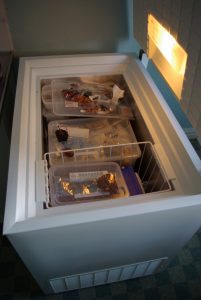
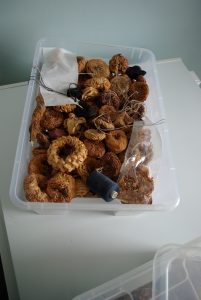
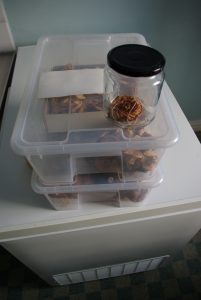
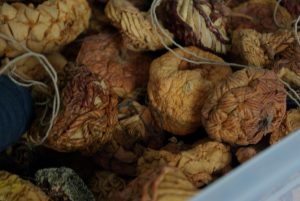
December 29, 2013
Dear Paweł,
I was in Łódź two weeks ago, and spoke with the curators along with some other people, which was very good. I will be working together with an ecological foundation called Fundacja Transformacja (transformacja.org). They will be partners in talking to the city, finding the best spots to plant the apple trees, finding the best old varieties, and transporting the little trees to the exhibition. After that, we will plant them all together in a kind of ceremony. We will also work with a food cooperative, that Ola [Aleksandra] Jach belongs to. They have about 100 members and we will try to find people to “adopt” the new trees and take care of them for the first few years.
I also found a beautiful documentary film by Catherine Peix about the origins of the apple in the mountains of Kazakhstan.[9] They grow in wild forests there. The trees have smaller apples and are very resistant to strong climate changes and illnesses. So it could make sense to plant this original apple, since it doesn’t need much care. Together with the people from Transformacja, we will try to find out how we can get these trees. We want to take a trip to Kazakhstan together if necessary.
So, all is going very well and I hope very much that it will turn out in a good way. I hope you like what is happening; please let me know …
Wishing you all the best, and a very peaceful and happy next year,
Antje
April 21, 2014
Dear Antje!
Piotr Życieński photographed each apple several times (in series). I have chosen one apple and one of Piotr’s photo series. I think that a series made about one apple is just the thing to introduce the collection that I created. I am glad that I can introduce my collection. This introduction will be my gift to Muzeum Sztuki in Łódź.
Joanna Sokołowska asked me about my suggestions regarding the way of presentation. Since the Apple is small (dried, shrunken to millimeter-size), the photos should be used to enlarge it into “meters.” I trust your intuition in the matter of resizing. (The photos are amazing.) That is it.
(I cannot stop thinking about the 1,000 apple plants in Łódź … ) Łódź has a little over 700,000 inhabitants. IF THE CITY PREPARES AND POINTS OUT THE PLACE (OR PLACES) FOR ONE PLANT FOR EACH NEW INHABITANT IN ŁÓDŹ (WRITES IT IN THE FUTURE OF THE CITY AND IS READY TO TAKE CARE OF THE ORCHARD … APPLE PARK), THEN IT IS POSSIBLE TO SAY THAT THE MUSEUM IS CONDUCTING ITS ART EDUCATION PROGRAM …
(a fruitful everyday life for coming generations).
Best wishes,
Paweł

Piotr Życieński, Pawel Freisler
Holy Apple, 2014
April 22, 2014
Dear Piotr, dear Paweł,
Oh, this photo is so beautiful! Thank you so much; you are really so generous!
I was already thinking that Piotr Życieński might photograph them very carefully, like Albert Renger-Patzsch,[10] and I am very happy to see that my intution was right! Only these are even more beautiful, because they are in color.
I also agree that it would be best to enlarge this photo and make it very big. I always, for some reason, envisioned one very big apple as part of the show. The extent to which we can enlarge it depends only on the size of the negative, or how big the file size is.
And can you tell us the best way to present the apple itself? Does it need to be in a vitrine, or maybe cooled? What is the best? You are the specialist …
In the meantime, I found the apples that I want to paint; they are in a book about apples by an ecological farmer who plants all the old varieties. I like the colored backgrounds and the simplicity of the images. I hope you like them.
Wishing you a very happy Easter!
All the best,
Antje
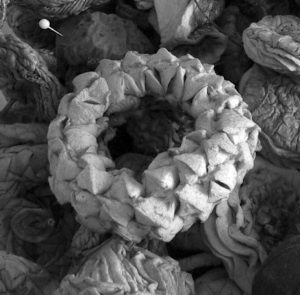
Apple by Freisler
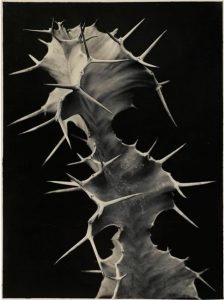
Image by Albert Renger-Patzsch

Apple photos, Lehrtafeln about old varieties.
April 26, 2014
Dear Antje,
You have written a very intense text. I suggest that the name of “the exhibition” should be enlarged with the word “introduction.” Introduction to something about apples that will continue over time in different places in the world. (It might contain the construction of machines for processing apples, or as I mentioned in my previous mail, projects of orchards or apple parks … etc., … it has to be presented to the city authorities … cities and etc., again). All this requires a lot of energy. One has to work hard without getting the feeling that one is doing hard work.
Your intuition usually is great. That is almost an axiom (bright) in our correspondence. If it fails it is only because something is disturbing you. So, let no one and nothing disturb you. Not even me.
Concerning photos of Piotr Życieński—believe me, your comparison with Albert Renger-Patzsch will seem like an exaggeration to some people but it is not. It is very accurate. I have been cooperating with Piotr since 1986; we are friends but we live far apart and unfortunately cannot work together on daily basis. Before Piotr will begin to photograph the entire collection … some time will go by.
I will speak with Piotr in even more detail about the introduction of my collection in Łódź. In the situation of an introduction, one apple equals the whole collection. The photos Piotr has already taken (of this particular apple) present an idea of how to photograph the whole collection. I think this is the right solution. I repeat: There will be ONE apple in the show with a series of photos made by Piotr Życieński.
The apple does not need a special exposition. Glass case? Especially for the apple? Why not. You decide how to show it.
So much so far.
Wish you all the best,
Paweł
May 2, 2014
Dear Paweł,
Thank you for your email; what you write is very kind! I of course agree to the title “Introduction to the Apple,” I think this is a very appropriate title. […]
May 8, 2014
Dear Antje,
Cultural activity touches alarmingly … actually all institutions distributing professional (and unprofessional) but intelligent—all kinds of art. Presenting contemporary art … (). List of Museums “für moderne Kunst in der Welt” [for Modern Art in the World] … How many are there in the world? Dozens … hundreds, two hundred is enough. The easiest way for you is to treat the whole museum structure of contemporary art as remaining at your disposal. … and so on … In such space, in such scale (?) one can, for instance, work out a calendar for the next several decades … 100 years. And for what purpose … (?) All the elements of “Introduction to the Apple” (certainly there are more in the subtext) “compressed” to the “presentation” at the Museum of Art in Łódź … introduction … of the next presentations of exhibitions and activities … on Apple … plural! A message … to implement … (!)
Antje … in my opinion … the apple and the series of photos made by Piotr Życieński will be sent to Łódź. Activation will occur after “MS Łódź” prepares a loan agreement promise, insurance … and so on. It would be nice if the documents were beautiful.
All the best, as usual,
Paweł
May 8, 2014
Dear Piotr,
I am Antje Majewski, the artist preparing the exhibition “Apple. An Introduction” at Muzeum Sztuki Łódź together with Paweł Freisler. Paweł sent us your beautiful photo of the apple; I love it very much! Aleksandra Jach (one of the curators) and I are in Warsaw next week on Monday and Tuesday (12th + 13th of May). Would you have time to meet?
Thank you and many greetings,
Antje and Aleksandra
May 8, 2014
Dear Antje,
There are too many misunderstandings in our communication. Antje … we are not doing this exhibition/presentation together. I am just present in your show in a very limited way.
I decided on one apple and a series of photos (of this apple) made by Piotr.
That is enough. That is it.
Best wishes,
Paweł
May 13, 2014
Dear Paweł, dear Piotr,
It makes no difference to me if you present one or 1,000 apples—your apple is the heart of the exhibition “Introduction to the Apple,” so your part is not small at all! Without you, this exhibition would never have been made.
I personally don’t care so much who the author is; the “World of Gimel” had a similar problem. The way I see it, the exhibition created itself and used me to organize it. This is a similar case. This is, I think, because they are not only “art” exhibitions—they participate in the world and in its creation.
So, regarding your other mail about your involvement in the show: I propose putting it like this: Antje Majewski, Paweł Freisler, Fundacja Transformacja.
I am now travelling with Aleksandra Jach and a camerawoman. Today we visited the Research Institute of Pomology and Floriculture at the Warsaw University of Life Sciences and had a long talk with the professor who created the “Ligol” apple, which is very popular in Poland.
Tomorrow we visit Tarczyn and a conventional farmer who will explain the use of chemicals. And Aleksandra and Joanna will be sending you beautiful documents very soon!
All the best, and greetings also to Piotr,
Antje
May 20, 2014
Dear Paweł,
I was in Warsaw and Łódź all of last week. We had a meeting with the deputy mayor of the city and two girls from the Parks Department, who like the project and can connect with it, because they already have a botanical collection of apples that was planted with the help of Grzegorz Hodun (who we also met—the expert on old varieties). They can imagine expanding this collection to parks and schools, to public but still protected places.
The 100 trees that have already been bought are good old Polish varieties, like Papierówka [White Transparent]. And the people from Fundacja Transformacja are really dedicated. So, all in all, very good news!
All the best,
Antje
May 24, 2014
Dear Antje,
It is great that the show you are organizing (your show) is getting sharp. I think the creation process of parks-orchards in a big, gigantic scale is ongoing, and to proclaim it, now and in the future, will be culturally crucial. “Introduction to the Apple” will be current over and over again. All pieces should connect. […] For a long time, I wondered why the Romans (?), the ancient people, came out with this “saying” ab ovo usque ad mala. It is quite pleasant not having an answer.
I have a surprise for you; I think it is a very real one. I have been in contact with a Polish company called ZORTRAX. Please look at what they are doing online. I decided to recognize their product as an art object. It is a tool that cannot be overlooked, especially when it comes to objects like my dried apples (a dried apple). Multiplications seem precise. I carefully asked them if they would be interested in participating in the show at Muzeum Sztuki w Łodzi. I got a very nice, warm answer with the following message: “The presentation at the Łódź Art Museum sounds attractive; please give us more details so that we can thoroughly prepare and discuss this topic.”
Please get in touch with Anna Bogusz. I imagine their tool will cooperate with my dried apple. I have sent them the photo Piotr made of this particular apple.
You asked me if I had any suggestions regarding how to show my apple. That is my suggestion. That is all for now.
Wish you all the best,
Paweł
May 25, 2014
Dear Paweł,
I am indeed very surprised and I think it should work out well! I am mostly surprised because I thought your apple was meant to decay one day—but maybe not. I know the question of time is very important.
I can easily imagine your apple as a 3D copy … I am sure it will look very beautiful. I am quite happy that in this way, the exhibition “Introduction to the Apple,” (for which I will look at the trees that have been growing in Kazakhstan for millions of years) will also have an element that is futuristic—a different kind of clone.
All the best!
Antje
P.S.: I read something about Ab ovo usque ad mala; it had to do with the Roman meals. They used to start with eggs and end with apples …
July 28, 2014
Hello Antje,
Just wishes in an extremely warm summer …
Paweł
July 30, 2014
Dear Paweł,
I also wish you all the best. Today is the day I start editing the apple film! I still need to film more. I will go to Kazakhstan on August 18. It sounds like a very exciting trip into the far away mountains. Attached you find some paintings, but they are not finished yet—it’s the first layer.
All the best for you,
Antje
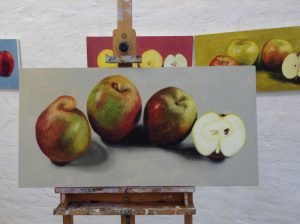
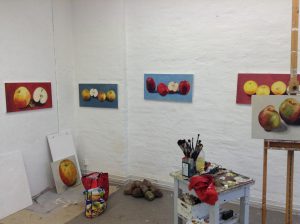
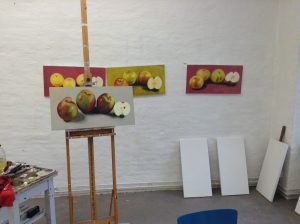
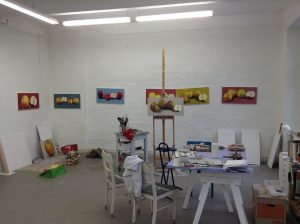
August 2, 2014
Dear Antje,
I am very curious about the film that you will do in Paradise. Where does curiosity end?
According to a saying, it ends in hell. Apropos immortality.
I am especially curious about what you need to film more.
Please be careful far, far away. Wishing you good luck!
Paweł
August 3, 2014
Dear Paweł,
Will you come to the opening this time? It is on September 19. It would be very nice if you did!
Best wishes,
Antje
August 5, 2014
Dear Antje,
It is very important to me that we continue on: We will never meet.
It is one of my most important decisions in art that is under creation.
Best wishes,
Paweł
August 11, 2014
Dear Paweł,
I accept. But it’s a pity!
On the other hand, our mails are as if I were speaking to a bodiless “voice” in my head that doesn’t even have a specific voice because we’ve never even spoken on the telephone. So a bit like talking to “myself”—except it’s always surprising!
Thank you for this!
All the best,
Antje
August 11, 2014
Wonderful. I will refer to what you have written. Irrevocably.
Thank you,
Paweł
August 13, 2014
Our work with the apple is supplemented (carte blanche) with the demonstration of the 3D printing process of the object (specifically the dried apple and nothing more) performed by ZORTRAX. This will take about 11 hours, according to latest information. I think that I will be able to convince ZORTRAX to hold at least one lecture at the museum about the current status of 3D printing and its future. This has nothing to do with the promotion of the company even though one can think so. (Who decides what is art or not?) We are approaching the point.
Best wishes,
Paweł
August 14, 2014
Dear Paweł,
I am just now editing a part of the film—an interview at an apple juice factory. They have a process they use to extract aroma from the apple juice and add it back later on. Most of the concentrate is used in other juices or nectars that pretend to be raspberry, for example. Only five percent of the juice gets the aroma back. This aroma is a chemical composition that can also be produced in a laboratory, but “nature” is less expensive to make. But is this—what’s growing on the industrial apple fields—still nature? It is a cultural/chemical product, or an interaction between humans, plants, and chemistry (and still: some insects!). So far, plants are still the most efficient “machines” when it comes to producing what we need. Maybe everything will be printable in the future—not only the forms, but every molecule of everything.
All the best,
Antje
August 31, 2014
Hello Joanna and Ola, Aga, Maggie, Paweł, and Łukasz,[11]
I am back in Berlin after a 10-day trip to Kazakhstan, to two different national parks with wild apples (Malus sieversii). Everything went well! I traveled with three Austrian pomologists from “Arche Noah” (https://www.arche-noah.at/english), a project that works to preserve old varieties and endangered species. We drove many hundreds of kilometers in a minibus, first on highway and in the end always on bumpy dirt routes … and found a whole forest of wild apples in Zhongar-Alatau State National Park—it was really magical!
We weren’t allowed into the second park near Urzhar, even with a permit, but we could at least see some even smaller and bushier wild apples in the fields. On the last day, I walked up the mountains of Kok-Zhailau in Ile-Alatau National Park—very close to Almaty, where I could also see wild apple trees. All the parks are endangered for various reasons. In Kok-Zhailau, they want to build a ski resort for the super rich people of Almaty. I met great Kazakh people while traveling with botanist Vladimir Kolbintsev and meeting with activists from the “Green Salvation” [ecological society] and the “Save Kok-Zhailau” movement.
The Austrians from Arche Noah and I both took seeds and branches and brought them back home. Tomorrow I will try to graft one branch onto an apple tree in my garden, and hope it will survive (it’s not the right season for this). The Austrians have a lot of experience and are confident that they can make the branches grow. They also promised to send me one of these little trees.
In the plane on the way back, it suddenly occurred to me that this “stealing” of the Wild Apple—which is officially not allowed, because you are not allowed to take genetic resources from countries without permission—is a sort of reverse of stealing The Egg in my first performance work reacting to Paweł Freisler’s work, with Agnieszka Polska. At the time, Paweł said to me, “If you steal one egg, you might as well multiply and steal 1,001 eggs.” So in the end, if all goes well, we will not have eggs but apples—more then 1,001 apples growing on Malus sieversii trees smuggled across the Kazakhstan border and now thriving in Łódź, in Austria, in my garden, and wherever someone else wants to propagate it.
The Malus sieversii apples can be very different: red, green, yellow. Most are small, but some are nearly the size of cultivars; they are usually very bitter and sour, but some suddenly taste marvelous!
I will send more images soon.
I am very happy about everything and now have to hurry up and finish the film.
All the best to all of you,
Antje
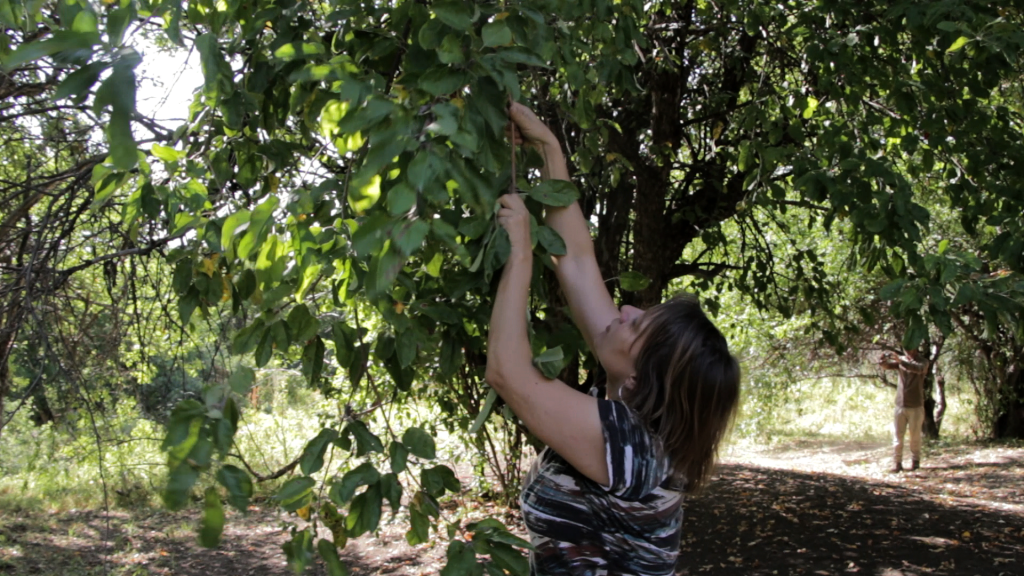 ANTJE IN PARADISE
ANTJE IN PARADISE
September 14, 2014
Dear Antje,
After a short break … absent absence in Outlook …
The photos you sent affected me. I think your expedition to the primordial wild apple forests (dying) is very close to the point. It should remain this way. Thank you very much. (To be continued). I am waiting for the documentation as a film.
Wild apple trees grow in Olsztyn, in the heart of city. I do not know how many or where they are from. I did not take any photos … (It isn’t always art to make photos; it is art not to do it just when you want it most. To force yourself to think about it and recall it in your memory, with all the details).
Wish you all the best,
Paweł
September 14, 2014
Dear Paweł,
The wild apple trees in Olsztyn (if they have very small and bitter apples) are most likely Malus sylvestris, the European wild apple (a distant cousin of Malus sieversii in Kazakhstan and our cultured apples). Unfortunately, they are also vanishing because people have no use for them. One place I visited (the Julius Kühn-Institut in Dresden-Pillnitz) grows almost every sort of wild apple and they also run programs to save the European wild apples.
All the best,
Antje
September 15, 2014
Dear Antje,
I forgot to write that ZORTRAX has a headquarters in Olsztyn. The white apple I got from Łukasz could be painted. Just like that. I will try to move it in time. I will even try to change its visuality. It can be multiplied. I think you could paint one of the white multiples if you have a “good day.” I would be happy. It seems that the wild apples in Olsztyn are, as you wrote, Malus sylvestris—small, yellow, bitter.
They are not poisonous as I survived, but not without some stomach sensations.
All the best,
Paweł
October 11, 2014
Dear Antje,
I can see that you are about to “close” the exhibition in Łódz, our exhibition.
For me, it is still the beginning of work with the concept of immortality (apropos traditions older than Ab ovo …)
I would like to thank you, a little bit earlier then right on time, for getting me involved in the mechanism of the Muzeum Sztuki in Łódź. You manage to weaken my resistence, which usually is immovable, even for me. As we enigmatically mentioned, I will present my collection of dried apples …
Of course you are present in my thoughts about the future. I will keep you informed about my moves.
So far, my mind has embraced your journey to Paradise as an art object and I have very carefully archived the short description of it that you sent to me via email. I write that I am not curious about the documentary film you made, as curiosity is the first step to hell.
Is it ready? Are you satisfied? How do you price it? Are you comfortable with the result? —————————————————————————————————————————————————————– Before the opening, some words …
3D: Łukasz Łazarczyk sent me the first print of the dried apple from the exhibition. It is enlarged a couple of times. It is a big plastic object (like an apple) that hardly fits in my hand. The enlargement upset me at first. Apples of that size are medium-large in real life, but in the plastic version it is big. I thought about painting the plastic and taking photographs although
I gave up this thought rather quickly, because Łukasz told me that what is filled could be empty inside and the peduncle of the apple can be screwed on, for example. I started to think about different versions
(possible and impossible to make). I have lived with the print for some weeks now. (Łukasz warned me to be careful with the peduncle and of course I broke it. This has also become important.)
Then I decided to make a color print copy of the photo of the apple on a very thin, almost transparent paper and wrap the plastic apple in it. Now I think the size of the print is good. ——————————————— Łukasz decided to give a short lecture. You will probably meet him at the opening.
Wishing you good luck!
Paweł
October 15, 2014
Dear Paweł,
Thank you very, very much for your good wishes! As you wrote, I am in the middle of preparations and it helps me that you are also thinking about it …
My film is now ready (a first version!), but there were many technical problems, as always with video. But I am really quite satisfied for a start. I think the film contains some important sentences, said by Jimmie Durham (a great artist who will also be included in the show in Łódz, because he planted apple trees at the last documenta and made nice labels for apple juice bottles), by Eckart Brandt, an organic farmer and pomologist from Northern Germany who has collected several hundred old apple varieties), and Erzhan Ashim, a Kazakh activist who is working to preserve a national park near Almaty, where Malus sieversii grow wild. There are many more people in the film … but still I could keep going!
Aleksandra Jach, the curator, also sends her greetings! I am now sitting in the exhibition space, which has very nice, bright colors—light orange and green.
Many greetings,
Antje
November 7, 2014
Dear Paweł,
Oh, I am so sorry—I just realized that I forgot to write to you just after the opening! I hope your friend Piotr, who I met and had a very nice talk with, has already sent you some photos. The opening and planting ceremony were so nice, especially the singing! The singers themselves invented this new “ritual” with the red ribbon. Another apple woman held a public competition for haikus about apples. The three winning poems were read aloud by an actress who I dressed up, and then they hung the haikus in the trees. To tell you the truth, I think the only thing missing was you—it would have been really nice if you had been there!
We have been invited to show the entire exhibition “over and over and once again” in Museum Abteiberg in Mönchengladbach next year in July! I am really happy about this. It’s a very nice museum and they also want to make a publication, so I hope we can print not only one but several photos of your apples. So the project is growing now—just as we both had hoped! We will also be able to work with a park and a youth center in Mönchengladbach, so hopefully we can plant more trees, and by that time wild Kazakh apples as well.
The reason I forgot to write was probably because I went to Stockholm with my students two weeks ago and I was afraid you would feel like I had come to visit you … but I don’t think we met, so all is good.
I hope all is well with you,
Antje
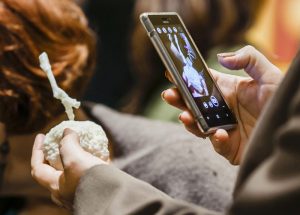
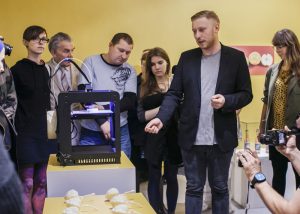
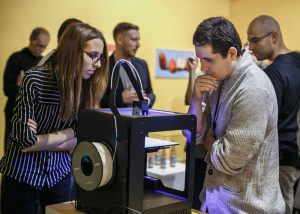
Opening of exhibition “Apple. An Introduction. Over and over again.” with a demonstration by the company ZORTRAX, showing how the 3D printer works. Muzeum Sztuki, Łódź
© Anna Taraska-Pietrzak
etc…
November 8, 2014
Dear Antje,
Thank you very much for writing, and for the photos. I see your paintings—they look very good on a crowded photo, which means they can defend themselves.
Of the photos you sent me there is one that I think is very good. Not only as a document but also as an art object. It is the photo showing the mobile phone taking a photo.
I look for art all the time. I try to concentrate only on this. Even in the context of the exhibition you made in Łódz. This time what you wrote I will try to understand this way.
Initially I agree on Mönchengladbach. OK.
Now I will start to think about it, at my own tempo. I will write more about everything you wrote, without any hurry.
Until next time … with best wishes,
Paweł
November 8, 2014
Dear Paweł,
I agree very much that art is happening all the time! It’s funny—a good friend of mine in Sweden, the painter Cecilia Edefalk, thought that the photos of the people looking at the 3D-printer were actually paintings of mine! She was very confused. I told her no, that really happened, but of course for me this was also art, and all people participating in the 3D printing demonstration, the planting or the workshops are also participating in art. It’s a very nice thought.
All the best,
Antje
January 31, 2015
Dear Antje,
I hope you are well or even better. Welcome to my 2015! I hope you will never be as behind on the calendar as I am
(I have even stopped thinking that there are months or years). The impression of time differs. In the first quarter I will not be present actually.
Until today, we have had two sunny days this year.
Let’s continue … backlog and future. I never answered some of your friendly “suggestions” …
Simplifying … ab ovo usque ad mala, had a rather homogenous meaning
in different ages, and in the Roman Empire. It does not mean that in the proverb (in ad mala—synonym to the end); the previous symbolic meanings did not survive into our time. Such like immortality … mortality for example. Fondness (Folk expression—the apple in the snout of swine.) The confusion of meanings is our own, artistic, self-styled privilege. (The choice is important even if it is not accurate historically). On your question regarding the painting of the apple on an apple I answer after and before the next exhibition …
I imagine your painted apples (the ones I saw on the photos online) as reproductions, printed with maximum gentleness (preferring lithography) on very thin tissue paper. Signed, numbered, dated in a limited edition. What do you think about wrapping chosen objects (dried apples) in your tissue paper lithography? Briefly … an explanation about the process. Your observation of nature in form of lithography, my cooperation with nature in the form of a dried object.
Details have to be worked out.
I thought I would write a very long email to you today … it does not seem to be the case.
Until next time …
Paweł
February 1, 2015
Dear Paweł,
I also wish you a very nice 2015 and I agree that my 2015 seems to be starting very slowly as well—I haven’t been wanting to work any more lately, just sleep or read, and wait for times with more sunlight.
I like your idea about the apples paintings printed on thin tissue paper very much. Only I’ve never done lithograhy before, so I need to ask about this. But it seems like a very good idea. In fact, I want to make a new painting for the show in Mönchengladbach. It will be of the inside of an apple. When you cut an apple horizontally, you see a star with 5 points containing the seeds. This is what I want to paint. The other paintings, which show the surface/outside, could also become wrapping paper in limited editions. We could sell these prints in the museum shop to make money to plant more apple trees.
We will be planting more trees again. The 100 first trees in Łódz have found people to take care of them and the last of them will be planted in spring. So this part is a success and will also go on!
In Mönchengladbach, I spoke with the city planner, Parks Department, and local citizens’ garden groups. They are all very happy about the project and we will plant first six trees in April, and many more all over the city in October.
I feel like our collaboration is taking place in a different time (as you also always say) that is not “bound in time.” I have always understood the apple and the egg as having to do with mortality/immortality, end/endless, the round shape (infinite) and the egg shape (bulging out to one side, to give birth and set the path of time in motion) … and fondness is very important!
Over the past couple of years, whenever I tell people that I have been all involved with apples, they laugh in a very fond way. Somehow the people seem surprised, and like it. It makes me happy.
I’m not familiar with the saying about the apple in the snout of a swine; what does it mean?
I wish you all the best and look forward to your answers …
Antje
February 7, 2015
Dear Antje,
“The apple in the snout of a swine” is a direct translation from the Polish language: jabłko w ryju świni. It has a slight association with the head of a wild pig … Please google “roasted piglet” and look at the pictures. Therefore the thousands years old folk art.
My grandparents (on my father’s side) lived in Nowy Sącz, very close to the orchards of Łącko (a very old, traditional area with orchards). In Łącko there is an annual folk festival in May, celebrating the blooming apple trees.
A word about how an apple combined with a plum: a long time ago, Łącko was known for its śliwowica or plum vodka, actually more like plum spirits (spirytus in Polish). I would visit the Łącko area with my grandfather to buy apples, which means we would come back home with śliwowica in one-liter bottles. Mr. Koza’s cart was filled with bottles. The śliwowica was called “Białe kopyto” (White Hoof). This spirit was used to produce other tinctures and syrups, not only in my grandparents’ house, but at the neighbors’ as well. (It was also the strongest to drink.) Making śliwowica was not allowed in Poland back then. So you always traveled to Łącko for apples. On the other hand, the Łącko apple (one of the sorts) was a favorite ingredient for our sour cabbage. My grandmother always made sour cabbage in an (oak) woodbarrel, and put whole apples into it to sour. Those were the finest, tastiest apples I have ever eaten in my life (the soured ones). My grandmother’s family was spread all over the Podhale, the Polish highlands, (on both sides of what is now the border between Poland and Slovakia). A lot of them were also in the Ukraine, Moldavia, Romania, and Hungary. The family was a very old one, with a tradition of robbery. My grandfather’s parents lived nearby in Ostrava, in the Czech part of Silesia in a village now known as Bravantice (Brosdorf). This is a very long story and it can be complicated as well.
All the best,
Paweł
March 10, 2015
Dear Paweł,
My mother used to cook sauerkraut with apples, too—very delicious. Polish and German cuisine have some similar dishes. My family comes from the area between Leipzig and Freiberg in Germany (mother’s side) and up to Gdańsk and Poznań in Poland (father’s side). My family name is Polish, but they were German-speaking. So I think Polish and German cultures have been mixing for many centuries in this region, of course together with Jewish culture. People married and shared recipes. You also find it in the apple tree names: many of the same varieties exist in both a Polish and a German version.
In any case, making things grow is always a good thing. To me, the diversity of apple trees created by pomologists in Poland, Germany, France, and England (and more) during all these times since the Middle Ages, with so many conflicts, shifting borders, and people dying for wars, is part of our true European heritage. To the trees, borders are non-existent. They have absolutely no meaning for them. That is also nice.
Wishing you some sunny, early spring days!
Antje